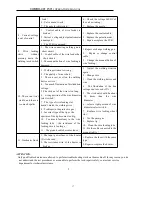
COMBO-401 i/501 i
OPERATOR’S MANUAL
2
Arc welding can be hazardous. All performing welding workers ought to have health qualification
that provided by authority organization. Protect yourself and others from possible serious injury or
death. Keep children away. Pacemaker wearers should consult with their doctor before operating. Be
sure that all installation, operation, maintenance and repair procedures are performed only by qualified
individuals.
1
Electric shock can kill
: The electrode and work (or ground) circuits are electrically “hot” when
the welder is on. Do not touch these “hot” parts with your bare skin or wet clothing, Wear dry,
hole-free gloves to insulate hands. Users need to follow the below items to avoid electric
shocks:
Insulate yourself from work and ground using dry insulation. Make certain the insulation is large enough to cover
your full area of physical contact with work and ground. Otherwise, use automatic or semiautomatic welding
machines, DC welding machines as possible as you can.
In semiautomatic or automatic wire welding, the electrode,electrode reel, welding head, nozzle or semiautomatic
welding gun are also electrically“hot”.
Always be sure the work cable makes a good electrical connection with the metal being welded. The connection
should be as close as possible to the area being welded.
Ground the work or metal to be welded to a good electrical(earth) ground.
Maintain the electrode holder, work clamp, welding cable and welding machine in good, safe operating condition.
Replace damaged insulation.
Never dip the electrode in water for cooling.
Never simultaneously touch electrically“hot”parts of electrode holders connected to two welders, because voltage
between the two can be the total of the open circuit voltage of both welders.
When working above floor level, please do wear safety belt to avoid falling or losing balance on electric shock.
2
Arc rays can burn
: Use a shield with the proper filter and cover plates to protect your eyes
from sparks and the rays of the arc when welding or observing open arc welding. Head shield
and filter lens should conform to nation standards.
Use suitable clothing made from durable flame-resistant material to protect your skin and that of
your helpers from the arc rays.
Protect other nearby personnel with suitable, non-flammable screening and/or warn them not to watch the arc nor
expose themselves to the arc rays or to hot spatter or metal.
3
Fumes and Gases can be dangerous
: Welding may produce fumes and gases hazardous to
health. Avoid breathing these fumes and gases. While working in limited room, use enough
ventilation and/or exhaust to keep fumes and gases away from the breathing zone, or use the
respirator.
Shielding gases used for arc welding can displace air and cause injury or death. Always use enough
ventilation,especially in confined areas, to insure breathing air is safe.
Do not weld in locations near chlorinated hydrocarbon vapors coming from degreasing, cleaning or spraying
operations.The heat and rays of the arc can react with solvent vapors to form phosgene, a highly toxic gas, and
other irritating products.
Read and understand the manufacturer’s instructions for this equipment and the consumables to be used, including
the material safety data sheet (MSDS) and follow your employer’s safety practices. Make sure they are asepsis
and innocuity.
4
Spatter
: Welding or cutting spatter can cause fire or explosion.
Remove fire hazards from the welding area.If this is not possible, cover them to prevent the
welding sparks from starting a fire. Remember that welding sparks and hot materials from
welding can easily go through small cracks and openings to adjacent areas. Avoid welding near
hydraulic lines. Have a fire extinguisher readily available.
Where compressed gases are to be used in the field, special precautions should be used to prevent explosion.
When not welding, make certain that no electriferous part is touching the work piece or the work stage.
Accidental contact can create a fire hazard.
Do not weld containers or lines, which are not proved to be innocuity.
Do not heat, cut or weld tanks, drums or containers until the proper steps have been taken to insure that such
procedures will not cause flammable or toxic vapors from substances inside. They can cause an explosion even though
they have been“cleaned”.
Spatter might cause burn. Wear leather gloves, heavy shirt, cuffless trousers, high shoes and a cap over your hair
to prevent from burning by spatter. Wear the ear shield when performing sideways or face up welding. Always
wear safety glasses with side shields when being in a welding area.
The welding cables should be as close to the welding area as possible, and the short, the better. Avoid welding
cables going through the building framework, lifting chains, AC or DC cables of other welding machines and
appliances. The welding current is strong enough to damage them while having short circuit with them.


















